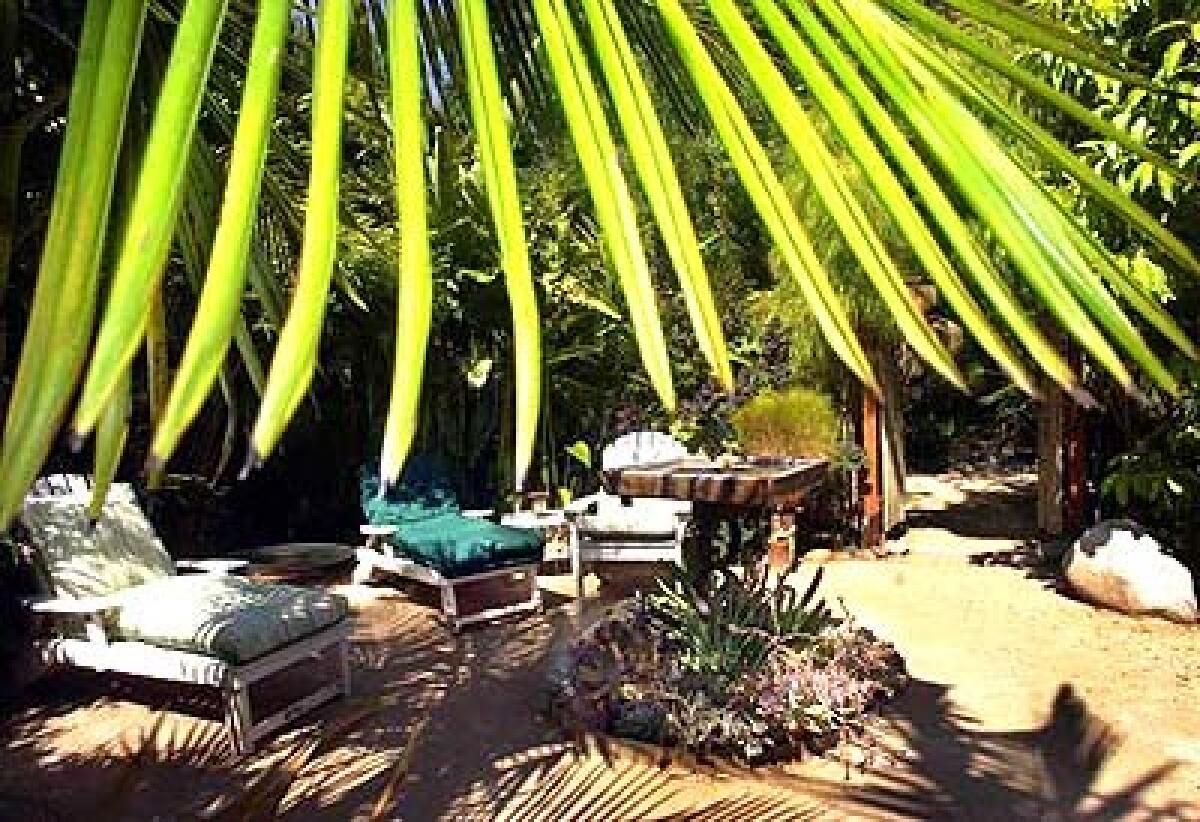An urban jungle

- Share via
The sun is high, the air is dry, and Michel Horvat has what may be the coolest spot in town, a tropical paradise in his own backyard. Splashes of color, exotic perfumes and the music of water permeate each shaded nook behind the tall bamboo and handcrafted gates.
And though the aura is totally tropical, the vegetation is not. Call it “tropical with a twist.” Horvat, a documentary filmmaker and TV writer, follows his eye and his imagination, not the rules. Plants from nearly every climate zone are bonded by geometry, tone and texture, and it works. This urban jungle in West Hollywood survives with average water and minimal upkeep. No misters or machetes needed.
Horvat is a handy guy, equally adept at science and the arts. The landscape is entirely his brainchild. He selects every plant and personally finds, makes or augments all decorative and functional touches. Wisdom and good sense extend to the whimsical lighting and water features, built from rescued materials and powered by the sun. To prevent runoff, all paving is permeable, including the decomposed granite surrounding a spitting-frog fountain and the long swath of resin-coated beach pebbles that glimmers like a wet shoreline.
Though still a work in progress, the garden’s metamorphosis in four short years is dramatic: from stark sun-scorched plot to inviting verdant hideaway.
Inspired by a visit to the Australian rainforest, Horvat accented his first garden room with a quartet of young king palms, now among his favorite plants. “They’re just lifting their skirts,” he says, referring to the lower fronds, “adding a new ceiling to the garden.”
Giant Burmese honeysuckle, one of many vines, has finished its fragrant show, and a potent fruity scent now dominates. It is Michelia champaca, an uncommon magnolia cousin with shiny foliage and creamy yellow flowers. At its feet, in sharp contrast, are a bushy purple-leafed smoke tree, Cotinus coggygria, and multihued New Zealand flax.
Rustling bamboos and towering heliconias with waxy red-and-yellow bracts flank the opposite wall. Plumerias, cannas and a handsome clump of Philodendron ‘Xanadu’ fill an adjacent bed. Across the path, Zamia furfuracea, a cycad with felty green leaflets, is boldly paired with Salvia discolor, an ash-gray sage with near-black flowers. It works.
A second garden room, entered through a bamboo gate, holds more heliconias, plus ferns, Swiss cheese plant, Japanese maple, late cymbidium orchids and what Horvat calls “other fun stuff.” A leaning Chinese elm guards a pond stocked with aquatic plants, 50-cent feeder fish liberated from a pet store and tiny brown gambusia, or mosquitofish, available free from the L.A. County West Vector Control District ([310] 915-7370).
All details are carefully orchestrated: the summer-annual celosia in fiery shades of crimson and gold, a deep-orange bougainvillea to match the trim of the house, succulents that play off each other and the shapes and colors of their containers. “Plants have personality,” Horvat says.
And he treats them well, using planting mix and organic mulch when setting out his transplants. The king palms were given slow-release fertilizer to get them going, but nothing else is fed. Though lush and dense, the garden has virtually no pests. Like any tropical Eden, it teems with well-nourished hummingbirds and butterflies.
As might be expected, Horvat’s taste in nurseries is eclectic. For instant screening, he found specimen-sized Mexican weeping and ‘Alphonse Karr’ bamboos at Endangered Species in Perris, Calif. (www.endangeredspecies.com). He frequents San Gabriel Nursery (www.sgnursery.com) for its good selection of succulents in small pots and likes Four Seasons Orchid across the street from the San Gabriel Nursery, which also sells ferns.
Many plants were obtained from legendary nurseryman Gary Hammer of Worldwide Exotics. His far-ranging inventory features tropical, subtropical, Mediterranean and desert plants adaptable to Southern California’s climate.
“It’s amazing what you can do in a small yard,” says Hammer, “if you look carefully at placement and create little microclimates.”
He grows 10 different heliconias that are reliably hardy outdoors and is experimenting with palm-like cordylines and big-leafed “elephant ears.” Some, he’s found, are extremely tough.
Bromeliads are everywhere in the tropics, and mostly up in trees. For outdoor landscapes here, Hammer recommends old-fashioned Billbergia, or queen’s tears, and the new Aechmea recurvata hybrids, which he says are durable, take a lot of light without burning and produce beautiful long-lasting flowers, mostly in late winter and early spring.
No tropical refuge is complete without tillandsias, a large and diverse group of bromeliads collectively called air plants. Hammer sells an assortment and passes on the following rule: The grayer the leaves, the more sun they can tolerate.
He’s also fond of Neomarica caerulea, a tall iris relative with sculptural form and cobalt blue flowers. For more ideas, visit him at the Worldwide Exotics booth at the Pasadena City College swap meet on the first Sunday of each month and the Long Beach swap meet on the third Sunday.
Horvat continues building his garden for the “zen” of it. “There’s nothing like getting your hands dirty,” he says, “especially after being at the computer all day.” He gleans added insight from public gardens. His passion for succulents was boosted by a visit to the Los Angeles County Arboretum and Botanic Garden in Arcadia, and he’s planning a trip to the Virginia Robinson Gardens in Beverly Hills, home of the largest collection of king palms outside of Australia.
In a few days, he’ll roll in from his first San Francisco to Los Angeles AIDS/LifeCycle Bike Ride. He dreams of traveling to far-off Fiji or balmy Bora Bora. But, for now, he’s tied up with two film projects, and there’s no reason to hurry.
Tropical bliss, California style, lies just beyond his back door.






